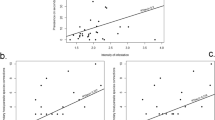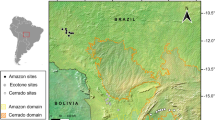Abstract
We examined the correlations between prevalence (proportion of infested individuals), mean intensity (number of parasites per infested individual), and the number of bat fly species parasitizing bats in Venezuela with host body mass, distribution, and abundance. Of 133 bat species sampled, 53 species in six families were captured frequently enough to allow estimation of their parasite loads. Over all species and six families, prevalence and mean intensity were uncorrelated with these variables, but the number of fly species was correlated with host body mass. Correlations of parasitism with body mass were strengthened among the 44 species of Phyllostomidae. Earlier studies showed that bat roosting habits influence their parasitism by bat flies with more permanent, enclosed roosts being with heavier parasitism. Multiple regressions of all measures of parasitism showed that roosting habits and host body mass, respectively, were the first variables to enter stepwise regressions, together accounting for 20–43% of the variation in measures of parasitism. Lack of correlation between proxies of distribution and abundance with parasitism is taken to indicate that proximate factors such as host-as-habitat, social groupings, and roost microhabitat take precedence over species-wide attributes like commonness and ubiquity.


Similar content being viewed by others
References
Altizer S, Nunn CL, Thrall PH, Gittleman JL, Antonovics J, Cunningham AA, Dobson AP, Ezenwa V, Jones KE, Pedersen AB, Poss M, Pulliam JRC (2003) Social organization and parasite risk in mammals: integrating theory and empirical studies. Ann Rev Ecol Evol Syst 34:517–547
Arneberg P, Skorping A, Grenfell B, Read AF (1998a) Host densities as determinants of abundance in parasite communities. Proc R Soc Lond B 265:1283–1290
Arneberg P, Skorping A, Read AF (1998b) Parasite abundance, body size, life histories, and the energetic equivalence rule. Am Nat 151:497–513
Bender JB (2000) Metabolic response of the Greater spear-nosed bat, Phyllostomus hastatus, to ectoparasitic batflies (Diptera: Streblidae). Unpublished Masters Thesis, Boston University, Boston, MA, p 63
Berger J, Stacey PB, Bellis L, Johnson MP (2001) A mammalian predator–prey imbalance: grizzly bear and wolf extinction affect avian neotropical migrants. Ecol Appl 11:947–960
Bush AO, Lafferty KD, Lotz JM, Shostak AW (1997) Parasitology meets ecology on its own terms: Margolis et al. revisited. J Parasitol 83:575–583
Coggins JR (1988) Methods for the ecological study of bat endoparasites. In: Kunz TH (ed) Ecological and behavioral methods for the study of bats. Smithsonian Institution Press, Washington, DC, pp 475–489
Dick CW (2005) Ecology and host specificity of bat flies (Diptera: Streblidae) and their Chiropteran hosts. Dissertation, Department of Biological Sciences, Texas Tech University, Lubbock, TX, p 253
Dick CW, Dick SC (2006) Effects of prior infestation on host choice of bat flies (Diptera: Streblidae). J Med Entomol 43:433–436
Dick CW, Gettinger D (2005) A faunal survey of streblid flies (Diptera: Streblidae) associated with bats in Paraguay. J Parasitol 91:1015–1024
Dick CW, Patterson BD (2006) Bat flies—obligate ectoparasites of bats. In: Morand S, Krasnov B, Poulin R (eds) Micromammals and macroparasites: from evolutionary ecology to management. Springer, Tokyo, pp 179–194
Dick CW, Patterson BD (2007) Against all odds: explaining high host specificity in dispersal-prone parasites. Int J Parasitol 37:871–876
Dittmar K, Porter ML, Murray S, Whiting MF (2006) Molecular phylogenetic analysis of nycteribiid and streblid bat flies (Diptera: Brachycera, Calyptratae): implications for host associations and phylogeographic origins. Mol Phylogenet Evol 38:155–170
Emmons LH, Feer F (1997) Neotropical rainforest mammals: a field guide, 2nd edn. University of Chicago Press, Chicago
Fenton A, Fairbairn JP, Norman R, Hudson PJ (2002) Parasite transmission: reconciling theory and reality. J Anim Ecol 71:893–905
Fritz GN (1983) Biology and ecology of bat flies (Diptera: Streblidae) on bats in the genus Carollia. J Med Entomol 20:1–10
Gardner AL (ed) (2008) Mammals of South America, vol. 1: marsupials, xenarthrans, shrews, and bats. University of Chicago Press, Chicago
Guégan J-F, Lambert A, Lévêque C, Combes C, Euzet L (1992) Can host body size explain the parasite species richness in tropical freshwater fishes? Oecologia 90:197–204
Guégan JF, Hugueny B (1994) A nested parasite species subset pattern in tropical fish: host as major determinant of parasite infracommunity structure. Oecologia 100:184–189
Hafner MS, Demastes JW, Spradling TA, Reed DL (2003) Cophylogeny between pocket gophers and chewing lice. In: Page RDM (ed) Tangled trees: phylogeny, cospeciation, and coevolution. University of Chicago Press, Chicago, pp 195–220
Handley CO Jr (1976) Mammals of the Smithsonian Venezuela Project. Brigham Young Univ Sci Bull Biol Ser 20:1–89
Hill JE, Smith JD (1984) Bats, a natural history. British Museum (Natural History), London
Hutchinson GE (1959) Homage to Santa Rosalia or why are there so many kinds of animals? Am Nat 93:145–159
Kalko EKV (1997) Diversity in tropical bats. In: Ulrich H (ed) Tropical biodiversity and systematics. Proceedings of the International Symposium on Biodiversity and Systematics in Tropical Ecosystems, 1994. Zoologisches Forschungsinstitut und Museum Alexander Koenig, Bonn, pp 13–43
Krasnov BR, Shenbrot GI, Medvedev SG, Vatschenok VS, Khokhlova IS (1997) Host–habitat relations as an important determinant of spatial distribution of flea assemblages (Siphonaptera) on rodents in the Negev Desert. Parasitology 114:159–173
Krasnov B, Shenbrot G, Khokhlova I (2002) The effect of host density on ectoparasite distribution: an example of a rodent parasitized by fleas. Ecology 83:164–175
Lim BK, Engstrom MD, Lee TEJ, Patton JC, Bickham JW (2004) Molecular differentiation of large species of fruit-eating bats (Artibeus) and phylogenetic relationships based on the cytochrome b gene. Acta Chiropt 6:1–12
Linares OJ (1998) Mamíferos de Venezuela. Sociedad Conservacionista Audubon de Venezuela, Caracas
MacArthur RH (1972) Geographical ecology: patterns in the distribution of species. Harper and Row, New York, NY
Marshall AG (1981) The ecology of ectoparasitic insects. Academic, London
Marshall AG (1982) Ecology of insects ectoparasitic on bats. In: Kunz TH (ed) Ecology of bats. Plenum, New York, NY, pp 369–401
Morand S, Krasnov BR, Poulin R (eds) (2006) Micromammals and macroparasites: from evolutionary ecology to management. Springer, Tokyo
Moura MO, Bordignon MO, Graciolli G (2003) Host characteristics do not affect community structure of ectoparasites on the fishing bat Noctilio leporinus (L., 1758) (Mammalia: Chiroptera). Mem Inst Oswaldo Cruz 98:811–815
Nowak RM (1999) Walker’s mammals of the world, 6th edn. Johns Hopkins University Press, Baltimore, MD
Overal WL (1980) Host-relations of the batfly Megistopoda aranea (Diptera: Streblidae) in Panama. Univ Kans Sci Bull 52:1–20
Packer C, Holt RD, Hudson PJ, Lafferty KD, Dobson AP (2003) Keeping the herds healthy and alert: implications of predator control for infectious disease. Ecol Lett 6:797–802
Patterson BD, Pacheco V, Solari S (1996) Distributions of bats along an elevational gradient in the Andes of south-eastern Peru. J Zool 240:637–658
Patterson BD, Willig MR, Stevens RD (2003) Trophic strategies, niche partitioning, and patterns of ecological organization. In: Kunz TH, Fenton MB (eds) Bat ecology. University of Chicago Press, Chicago, IL, pp 536–579
Patterson BD, Dick CW, Dittmar K (2007) Roosting habits of bats affect their parasitism by bat flies (Diptera: Streblidae). J Trop Ecol 23:177–189
Patterson BD, Dick CW, Dittmar K (2008) Sex biases in parasitism of Neotropical bats by bat flies (Diptera: Streblidae). J Trop Ecol 24:387–396
Perez-Orella C, Schulte-Hostedde AI (2005) Effects of sex and body size on ectoparasite loads in the northern flying squirrel (Glaucomys sabrinus). Can J Zool 83:1381–1385
Poulin R (1991) Group-living and infestation by ectoparasites in passerines. Condor 93:418–423
Poulin R (1995) Phylogeny, ecology, and the richness of parasite communities in vertebrates. Ecol Monog 65:283–302
Poulin R (1997) Species richness of parasite assemblages: evolution and patterns. Ann Rev Ecolog Syst 28:341–358
Poulin R (1998) Evolutionary ecology of parasites: from individuals to communities. Chapman and Hall, London
Poulin R (2007) Evolutionary ecology of parasites, 2nd edn. Princeton University Press, Princeton, NJ
Poulin R, George-Nascimento M (2007) The scaling of total parasite biomass with host body mass. Int J Parasitol 37:359–364
Presley SJ, Willig MR (2008) Intraspecific patterns of ectoparasite abundances on Paraguayan bats: effects of host sex and body size. J Trop Ecol 24:75–83
Rainey WE, Pierson ED, Elmqvist T, Cox PA (1995) The role of flying foxes (Pteropodidae) in oceanic island ecosystems of the Pacific. In: Racey PA, Swift SM (eds) Ecology, evolution and behaviour of bats. Clarendon, Oxford, pp 47–62
Silva M, Downing JA (1995) CRC handbook of mammalian body masses. CRC, Boca Raton, FL
Simmons NB, Voss RS (1998) The mammals of Paracou, French Guiana: a neotropical lowland rainforest fauna. Part I. Bats. Bull Am Mus Nat Hist 237:1–219
Simmons NB, Seymour KL, Habersetzer J, Gunnell GF (2008) Primitive early Eocene bat from Wyoming and the evolution of flight and echolocation. Nature 451:818–821
Solari S, Pacheco V, Luna L, Velazco PM, Patterson BD (2006) Mammals of the Manu Biosphere Reserve. In: Patterson BD, Stotz DF, Solari S (eds) Mammals and birds of the Manu Biosphere Reserve, Peru. Fieldiana: Zoology, new series, Chicago, pp 13–22
StatSoft Inc (2003) Statistica (data analysis software system), version 6. Available at http://www.statsoft.com
Teeling EC, Scally M, Kao DJ, Romagnoli ML, Springer MS, Stanhope MJ (2000) Molecular evidence regarding the origin of echolocation and flight in bats. Nature 403:188–192
Tello JS, Stevens RD, Dick CW (2008) Patterns of species co-occurrence and density compensation: a test for interspecific competition in bat ectoparasite communities. Oikos 117:693–702
Terborgh J (1988) The big things that run the world—a sequel to E. O. Wilson. Conserv Biol 2:402–403
ter Hofstede HM, Fenton MB (2005) Relationships between roost preferences, ectoparasite density, and grooming behaviour of neotropical bats. J Zool 266:333–340
ter Hofstede HM, Fenton MB, Whitaker JOJ (2004) Host and host-site specificity of bat flies (Diptera: Streblidae and Nycteribiidae) on Neotropical bats (Chiroptera). Can J Zool 82:616–626
Thewissen JGM, Babcock SK (1992) The origin of flight in bats. BioScience 42:340–345
Thompson JN (1999) The evolution of species interactions. Science 284:2116–2118
Tuttle MD (1983) Can rain forests survive without bats? Bats 1:1–2
Wenzel RL (1976) The streblid batflies of Venezuela (Diptera: Streblidae). Brigham Young Univ Sci Bull Biol Ser 20:1–177
Wenzel RL, Tipton VJ, Kiewlicz A (1966) The streblid batflies of Panama (Diptera Calypterae: Streblidae). In: Wenzel RL, Tipton VJ (eds) Ectoparasites of Panama. Field Museum of Natural History, Chicago, pp 405–675
Whiteman NK, Parker PG (2004) Effects of host sociality on ectoparasite population biology. J Parasitol 90:939–947
Wilson DE (1989) Bats. In: Lieth H, Werger MJA (eds) Tropical rain forest ecosystems. Biogeographical and ecological studies. Elsevier, Amsterdam, pp 365–382
Acknowledgements
We owe special debts of gratitude to Charles O. Handley, Jr. and Rupert L. Wenzel, both now deceased, for their remarkable taxonomic expertise and great efforts to sort, identify, and describe the mammals and streblids of the SVP. We are grateful to Scott Lidgard for insightful discussions of analyses, Matt Dean and Jamie Bender for their help in developing a database of the SVP records, and the National Science Foundation (DBI-0545051 and DEB-0640330/1) and Stephanie Ware for the support to complete their development.
Author information
Authors and Affiliations
Corresponding author
Appendix
Appendix
Rights and permissions
About this article
Cite this article
Patterson, B.D., Dick, C.W. & Dittmar, K. Parasitism by bat flies (Diptera: Streblidae) on neotropical bats: effects of host body size, distribution, and abundance. Parasitol Res 103, 1091–1100 (2008). https://doi.org/10.1007/s00436-008-1097-y
Received:
Accepted:
Published:
Issue Date:
DOI: https://doi.org/10.1007/s00436-008-1097-y




